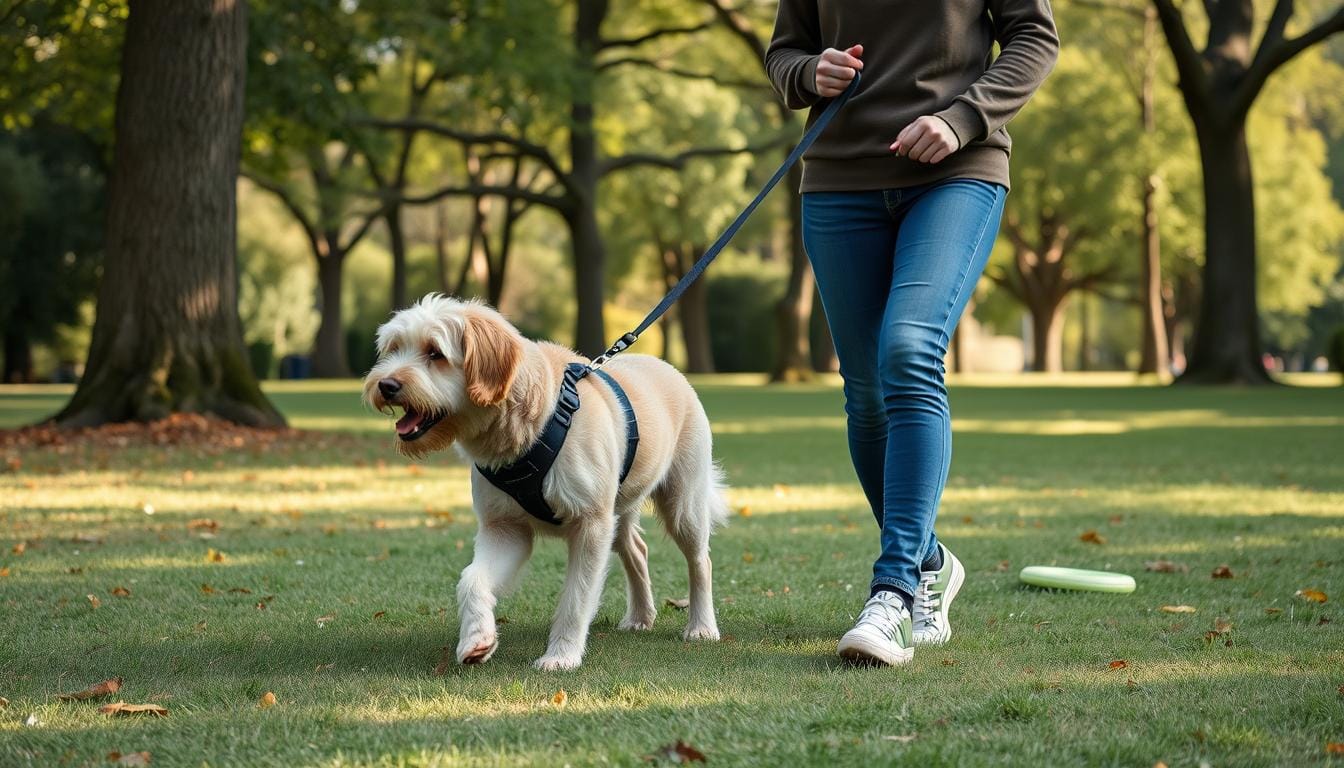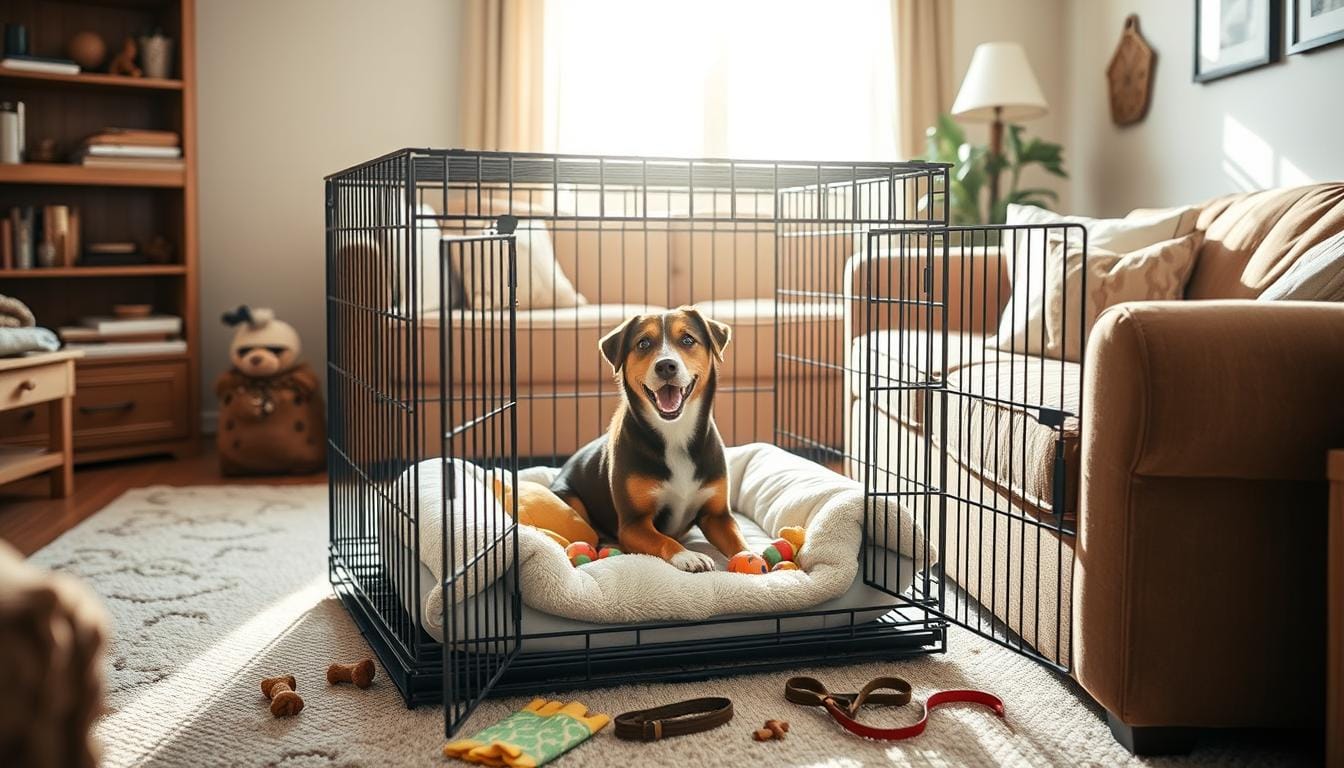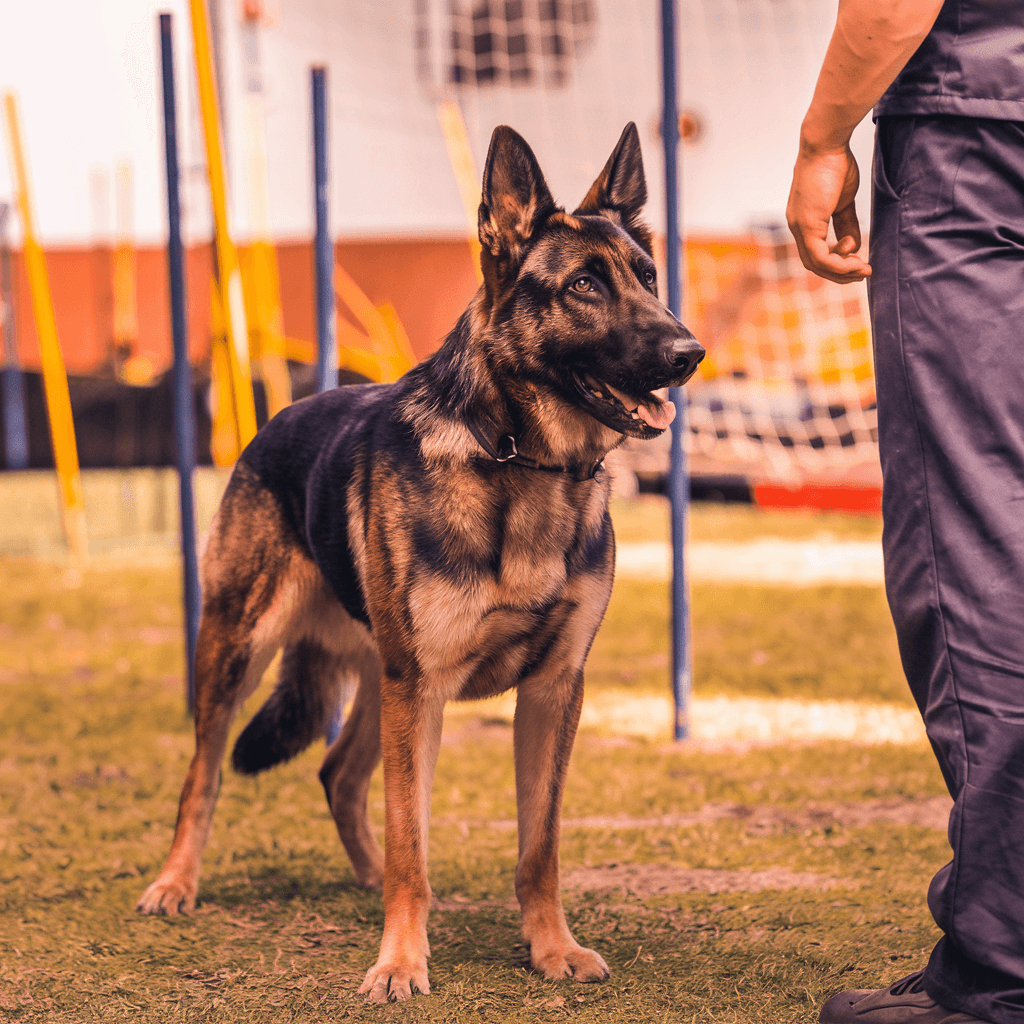Fleas and ticks are more than just a nuisance for our furry friends. They can cause serious health issues for dogs. That’s why flea prevention and tick protection are key for pet health. As dog owners, we want the best for our pets. We’re here to help you keep these pests away.
Dog care is more than just walks and belly rubs. It’s about protecting them from invisible threats. Flea and tick preventatives are vital for your dog’s health. Both pests can carry and transmit diseases.
Year-round protection is essential, as ticks can be active even in cold temperatures. There are many options available, like collars, topicals, and chewable tablets. The goal is to keep pests away before they can harm your pet.
Key Takeaways:
- Flea and tick prevention is crucial for dog health
- Various preventative products are available, including collars, topicals, and chewables
- Year-round protection is recommended due to pest activity in cooler temperatures
- Regular inspections and environmental management complement preventative measures
- Consult with a veterinarian to choose the safest and most effective prevention method
Understanding Flea and Tick Risks to Your Dog
Fleas and ticks are big threats to your dog’s health. They can be found all year, especially for dogs that go outside. Without protection, your dog can get infested in just a few weeks, leading to many health problems.
Common Health Issues Caused by Fleas
Fleas do more than just itch. They can cause skin problems, infections, and even tapeworms. Flea allergy dermatitis is a serious condition that makes dogs very uncomfortable.
Diseases Transmitted by Ticks
Ticks carry serious diseases. Lyme disease, anaplasmosis, and Rocky Mountain spotted fever are just a few. Keeping ticks away is key to keeping your dog healthy.
Signs of Flea and Tick Infestation
Spotting infestation signs early is important. Look for a lot of scratching, seeing fleas on your dog, and “flea dirt” (flea feces). Also, watch for red, irritated skin and moving specks in your dog’s fur.
| Parasite | Common Signs | Potential Health Risks |
|---|---|---|
| Fleas | Scratching, skin irritation, visible fleas | Skin infections, tapeworms, anemia |
| Ticks | Visible ticks, unexplained fever | Lyme disease, anaplasmosis, ehrlichiosis |
Remember, these parasites can also spread diseases to people. Keeping fleas and ticks away protects both your dog and you. Talk to your vet about the best ways to keep your dog safe.
Natural Prevention Methods
Keeping your furry friend safe from fleas and ticks doesn’t always mean harsh chemicals. We can use natural methods that are safe for pets. Let’s look at some ways to groom your dog, keep them safe, and control fleas naturally.
Regular Grooming Techniques
Regular grooming is key to preventing fleas and ticks. Use a fine-tooth flea comb to check for pests. If you find any, dunk them in soapy water. Bathing your dog with mild soap can kill adult fleas.
Remember, fleas can lay up to 50 eggs daily. So, grooming regularly is crucial.
Environmental Management
Your home environment is as important as your pet’s coat. Vacuum often, especially where your dog hangs out. Wash pet bedding weekly in hot water.
Consider using food-grade diatomaceous earth in your home. It’s a natural substance that can help get rid of fleas.

Yard Maintenance Tips
Don’t forget about your yard! Mow your lawn regularly and trim shrubs to reduce tick habitats. Apply cedar mulch, which acts as a natural repellent.
You can also use beneficial nematodes to control flea larvae in your yard. Creating a pest-repelling barrier with natural products containing essential oils can further enhance pet safety.
“Natural prevention methods are crucial in reducing the flea and tick population in your home and surroundings.”
By using these natural prevention methods, we can greatly reduce the risk of flea and tick infestations. This ensures pet safety. Remember, regular prevention is key to keeping these pests at bay.
Flea prevention, tick protection, pet health, dog care
Keeping our furry friends safe from fleas and ticks is key. Let’s look at ways to protect your dog’s health.
Essential Prevention Strategies
Preventing fleas and ticks needs a few steps. Use vet-approved products and check your pet and home often. Keeping things clean also helps a lot.
Year-Round Protection Importance
Many think flea and tick protection is just for warm months. But, it’s needed all year. Ticks can be active in cold, and fleas live indoors all the time. Keeping your dog protected all year is best.
Veterinary Guidance
Talking to a vet is crucial for a good prevention plan. They know what’s best for your dog based on their needs and lifestyle. This way, your pet gets the best care.
| Prevention Method | Benefits | Application Frequency |
|---|---|---|
| Oral preventatives | Long-lasting protection, easy to administer | Monthly or every 3 months |
| Topical treatments | Repels and kills parasites on contact | Monthly |
| Regular grooming | Early detection, removes loose parasites | 2-3 times per week |
Using these prevention steps and getting vet advice keeps dogs healthy. Learning about flea and tick control helps everyone stay healthy.
Choosing the Right Prevention Products
Protecting our furry friends from pesky parasites is a big task. We have many options like topical solutions, oral medications, and flea collars. Each has its own benefits, so picking the right one is key.

Topical solutions are simple to use and last a long time. You apply them to your dog’s skin, usually between the shoulder blades. They spread through your pet’s oils, creating a barrier against fleas and ticks.
Oral medications are popular for their ease and effectiveness. These chewable tablets are given monthly. They kill fleas and ticks from the inside out. Many like this method because it’s safe for kids and other pets.
Flea collars are a no-fuss way to keep pests away. They release ingredients that spread across your dog’s body. This provides ongoing protection for months. They’re great for dogs that spend a lot of time outside.
| Product Type | Duration of Protection | Application Method |
|---|---|---|
| Topical Solutions | 1 month | Applied to skin |
| Oral Medications | 1-3 months | Given as a chewable |
| Flea Collars | Up to 8 months | Worn around neck |
The best choice depends on your dog’s lifestyle, health, and your preferences. Always talk to your vet to find the best prevention product for your pet.
Safe Application of Preventative Treatments
We know how important it is to keep our pets safe from fleas and ticks. Using pet medication correctly is key. Let’s look at safe ways to apply it and how much to use to keep our pets healthy.
Proper Dosing by Weight
Getting the right dose is crucial for keeping pets safe. Most treatments work for pets over 4 pounds and 8 weeks old. Always check your dog’s weight before using any product to make sure you’re using the right amount.
Application Frequency
How often you need to apply treatments depends on the product. Most flea and tick preventatives need to be applied monthly. Some, like the Seresto collar, can last up to eight months. Others, like Bravecto, protect for up to 12 weeks. Always follow the recommended schedule for the best protection.
Safety Precautions
Here are some safety tips for applying pet medication:
- Apply topical treatments to intact skin only
- Keep treated dogs separate until the product dries
- Never use dog products on cats
- Monitor for side effects like skin irritation or vomiting
- Consult your vet if you notice any adverse reactions
Remember, protecting your pet from fleas and ticks all year is usually best in most of the U.S. Always talk to your vet to find the best way to protect your pet.
Home Environment Treatment
Dealing with fleas needs a full plan for home pest control. We’ll show you how to clean your home to get rid of fleas.
Indoor Cleaning Protocol
Begin by vacuuming well. Pay extra attention to carpets, rugs, and under furniture. Flea eggs hide there, making up 50% of the problem. Only 35% are larvae.
Throw away vacuum bags in sealed plastic to stop fleas from coming back.
Treating Bedding and Furniture
Wash your pet’s bedding in hot, soapy water. Clean places where your pet likes to hang out, like couches and chairs. Flea pupae, 10% of the problem, hide in these spots.
Professional Treatment Options
If fleas are really bad, get professional help. Experts use special treatments for all flea stages. They can also treat outside areas, important in warm, humid places like Southern California.
Stay away from DIY treatments like boric acid, cedar oil, or diatomaceous earth. They can harm pets and don’t work well against fleas. Use EPA-registered products for safe, effective flea control.
“It’s easier to keep fleas out of a home than to get rid of them.”
Keep your home clean and use preventive steps to stop fleas. Cleaning regularly helps fight current and future flea problems.
Monitoring and Regular Inspection
Keeping our furry friends safe from fleas and ticks is a big job. Regular pet health checks are key to spotting parasites early and keeping them away. Always check your dog after they go outside, looking in places where fleas and ticks like to hide.
Here’s a quick checklist for thorough inspections:
- Between toes
- Under the tail
- Around ears
- Armpits
- Head and neck area
Look for bumps and part the fur to see the skin. This helps find problems early and stops big infestations. Proper flea and tick prevention is vital for your pet’s health and happiness.
Keep a simple log of your inspections. Write down any parasites you find and how well your prevention works. This log is very helpful at vet visits, helping your vet find the best care for your dog.
“An ounce of prevention is worth a pound of cure.” This old saying is very true for keeping fleas and ticks away from our pets.
Fleas and ticks are not just a summer problem. They can be around all year, especially in places with mild winters. By making regular checks a part of your routine, you’re doing a lot to keep your dog safe and happy.
Special Considerations for Multiple Pet Households
Managing flea control in homes with many pets is a big job. It needs a team effort to keep all pets healthy. Homes with lots of animals face special challenges in stopping fleas from spreading.
Cross-Contamination Prevention
It’s very important to treat all pets at the same time in multi-pet homes. Treating all pets together stops fleas from moving from one pet to another. Always use products made for each pet’s species, as some dog treatments can harm cats.
Synchronized Treatment Schedules
Having a single treatment schedule for all pets is essential. This way, all pets get the protection they need. Use a calendar to keep track of when each pet needs their next flea treatment.
| Pet Type | Treatment Product | Application Frequency |
|---|---|---|
| Dogs | Oral chewable (e.g., Nexgard) | Monthly |
| Cats | Topical solution (e.g., Revolution) | Monthly |
| Both | Flea collar (e.g., Seresto) | Every 8 months |
Always watch all pets after applying treatments. Be careful of any interactions between pets, especially with topical treatments. By following these steps, we can keep our homes flea-free for all pets.
Conclusion
Keeping our pets safe from fleas and ticks is very important. We’ve looked at many ways to protect our furry friends. Regular grooming, managing their environment, and using treatments are key steps.
Fleas and ticks are a problem everywhere in the U.S., especially for dogs. They can make our pets sick, from skin problems to serious diseases. Using a combination of prevention methods can greatly lower these risks.
Choosing the right flea and tick prevention is crucial. There are many options, like oral tablets, spot-on treatments, and tick collars. Always talk to a vet to find the best one for your dog. Regular vet visits and watching your pet at home can catch problems early.
By being informed and proactive, we can keep our dogs healthy and happy all year. Let’s make sure to take good care of our pets. This way, we can enjoy fun times together without worry.
















